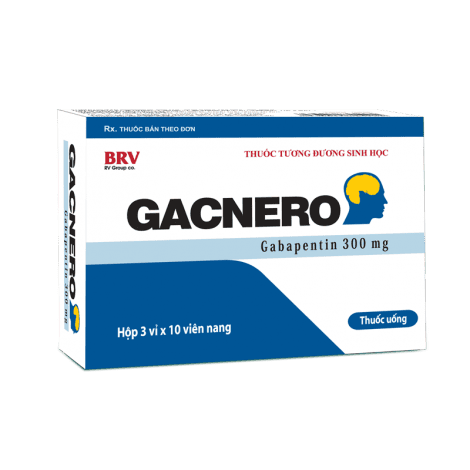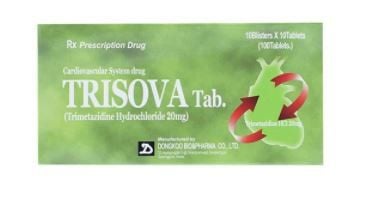This is an automatically translated article.
Rapozil is indicated in the treatment of partial seizures with or without secondary generalized seizures... Let's learn about the uses and precautions when using Rapozil through the article below.
1. Uses of the drug Rapozil
Rapozil medicine contains the active ingredient Gabapentin, which is prepared in the form of film-coated tablets with 2 strengths: Gabapentin 300mg and Gabapentin 600mg. Rapozil is indicated as monotherapy in the treatment of partial seizures with or without secondary degenerative generalized seizures in adults and children over 12 years of age.
2. Dosage of the drug Rapozil
The indicated dose of Rapozil depends on the specific condition of the patient as follows:
Treatment of neuralgia in adults:
The first day of taking a single dose of Rapozil 300; Day 2, take the dose of Rapozil 600 divided into 2 times morning and evening; On the third day, use the dose of Rapozil 900 divided into 3 times morning, noon and night; The maintenance dose can then be 1800mg, divided into 3 times morning, noon and night. Treatment of epilepsy:
The course of epilepsy treatment is long, so the doctor prescribes the drug based on the effect and tolerability of the patient. When it is necessary to reduce the dose of the drug, discontinue the drug or replace the treatment with another drug, it should be done gradually over a period of at least 1 week. The recommended dose of Rapozil in the treatment of epilepsy is as follows:
The first day of taking a single dose of Rapozil 300mg; Day 2: Take 300mg/time x 2 times/day; Day 3: Take 300mg/time x 3 times/day; Adults and children over 12 years of age are effective at doses of 900-3600mg/day. The course of treatment can be started with the standard dose as above or 300mg/time x 3 times/day, then adjust the dose based on the patient's response. The minimum time to reach the 1800mg dose is 7 days, 2 weeks for the 2400mg dose and 3 weeks for the 3600mg dose. For the elderly: The dose of Razopil should be started at 100 mg in the evening and increased to 100 mg daily until a dose of 600 mg/day divided into 2-3 oral doses.
Patients with renal impairment: The dose of Rapozil in patients with renal impairment should be adjusted based on creatinine clearance.
3. Undesirable effects
Rapozil may cause some unwanted effects as follows:
Serious side effects that need to be seen by a doctor include: Fever, chills, increased seizures, body aches, flu symptoms , swelling of the ankles or feet, confusion, tremors, easy bruising, in children taking Gabapentin there are symptoms of aggression, hostility, non-stop action, memory problems, and behavior changes. ... Less serious side effects include: Drowsiness, dizziness, weakness, fatigue, lack of coordination, blurred vision, vomiting, nausea, abdominal pain, loss of appetite, constipation, diarrhea discharge, dry mouth, stuffy nose, runny nose, sore throat, headache, sleep problems, acne and unusual dreams. If you experience these symptoms, the patient should stop using Rapozil and notify the doctor for appropriate treatment.
4. Notes when using Rapozil
Contraindicated to use Rapozil 300 and Rapozil 600 in patients with hypersensitivity to any ingredient of the drug.
Some notes when using Rapozil are as follows:
Do not stop the drug suddenly because of the risk of increasing the frequency of seizures, patients should be instructed to use Gabapentin only when prescribed by the treating doctor; Patients should be warned that Rapozil may cause drowsiness, dizziness, convulsions and other central nervous system symptoms. Therefore, do not drive or operate complex machinery until Gabapetin has been assessed as not causing any mental or motor harm; For pregnant women: There are no specific studies on the efficacy and safety of Gabapentin in pregnant women, so the drug should only be used in this population when the benefits outweigh the risks of treatment; Lactation: Since Gabapentin's ability to be excreted in breast milk is unknown, its use in lactating women should be prescribed by a physician when the benefits outweigh the risks.
5. Drug interactions
Rapozil can cause some interactions as follows:
Cimetidine : Gabapentin mean clearance will be reduced by 14% and creatinine clearance by 10% when co-administered with Cimetidine. In addition, Cimetidine may adversely affect the renal elimination of Gabapentin. Birth control pills: Studies have shown that the concentration of Norethindrone in daily oral contraceptives increases by 13% when used in combination with Gabapentin; Antacids: Gabapentin's bioavailability is reduced when used concomitantly with antacids. Therefore, it is recommended to take Rapozil at least 2 hours before taking an antacid; Probenecid: Probenecid blocks the active tubular secretion of Gabapentin, thereby increasing the concentration of Gabapentin, increasing the effect and risk of adverse effects of Rapozil. Scientific studies have shown that there is no effect when using Rapozil together with drugs such as Phenytoin, Valproic Acid, Phenobarbital, Carbamazepin... Drug interactions occur increasing the risk of having effects and reducing the therapeutic effect of the drug. Rapozil. Therefore, to ensure safety and effectiveness in treatment, patients need to inform their doctors about the drugs and foods they are using before taking Rapozil.
Please dial HOTLINE for more information or register for an appointment HERE. Download MyVinmec app to make appointments faster and to manage your bookings easily.













